Cultural Safety Action Plan: Improving Healthcare Communication
VerifiedAdded on 2022/11/16
|8
|1540
|347
Report
AI Summary
This report details a student's cultural safety action plan, designed to improve healthcare communication and patient care. The plan outlines goals, objectives, strategies, and evaluation methods to address communication barriers and ensure patients feel safe and informed. The report emphasizes the importance of providing a safe environment, ensuring equipment availability, maintaining patient privacy, and developing effective communication styles. The plan includes strategies for language support, health literacy training, and cultural competence. Furthermore, the report discusses the rationale behind the plan, implementation steps, resource requirements, and ways to overcome obstacles. The student highlights the need for multilingual staff, training programs, and continuous monitoring through patient surveys to assess the plan's success. References from various studies are included to support the strategies and approaches taken to achieve the goal of providing culturally safe healthcare.
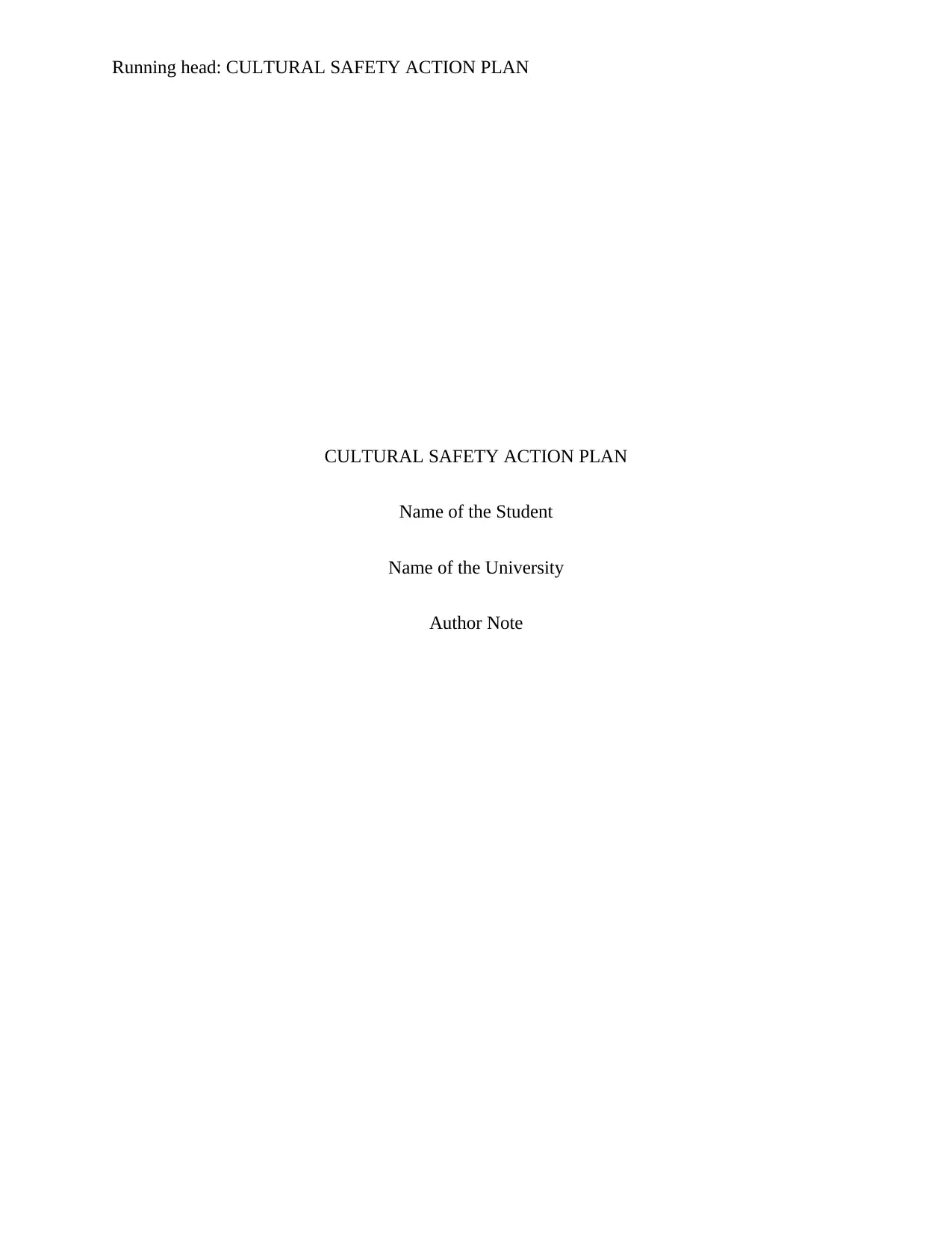
Running head: CULTURAL SAFETY ACTION PLAN
CULTURAL SAFETY ACTION PLAN
Name of the Student
Name of the University
Author Note
CULTURAL SAFETY ACTION PLAN
Name of the Student
Name of the University
Author Note
Paraphrase This Document
Need a fresh take? Get an instant paraphrase of this document with our AI Paraphraser
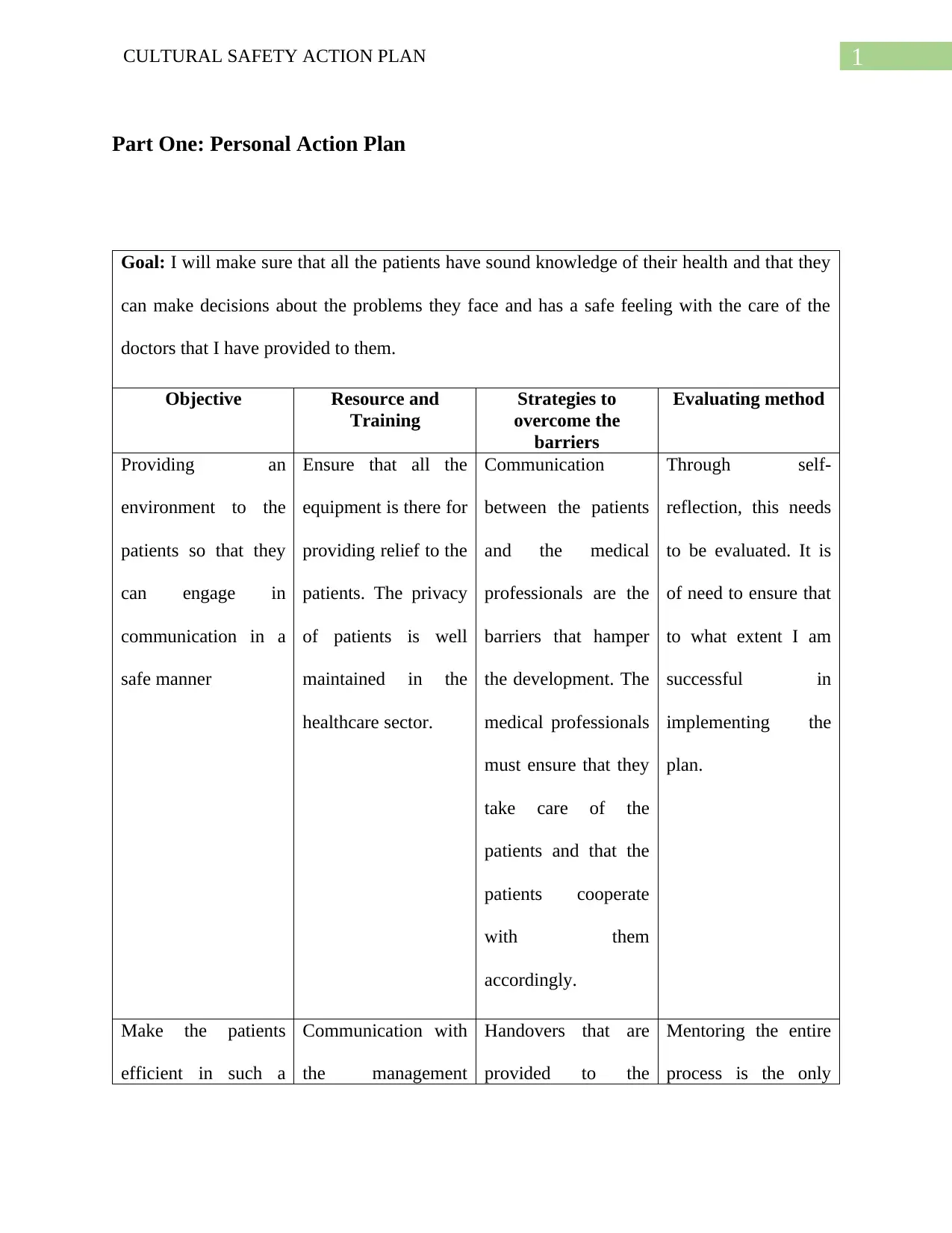
1CULTURAL SAFETY ACTION PLAN
Part One: Personal Action Plan
Goal: I will make sure that all the patients have sound knowledge of their health and that they
can make decisions about the problems they face and has a safe feeling with the care of the
doctors that I have provided to them.
Objective Resource and
Training
Strategies to
overcome the
barriers
Evaluating method
Providing an
environment to the
patients so that they
can engage in
communication in a
safe manner
Ensure that all the
equipment is there for
providing relief to the
patients. The privacy
of patients is well
maintained in the
healthcare sector.
Communication
between the patients
and the medical
professionals are the
barriers that hamper
the development. The
medical professionals
must ensure that they
take care of the
patients and that the
patients cooperate
with them
accordingly.
Through self-
reflection, this needs
to be evaluated. It is
of need to ensure that
to what extent I am
successful in
implementing the
plan.
Make the patients
efficient in such a
Communication with
the management
Handovers that are
provided to the
Mentoring the entire
process is the only
Part One: Personal Action Plan
Goal: I will make sure that all the patients have sound knowledge of their health and that they
can make decisions about the problems they face and has a safe feeling with the care of the
doctors that I have provided to them.
Objective Resource and
Training
Strategies to
overcome the
barriers
Evaluating method
Providing an
environment to the
patients so that they
can engage in
communication in a
safe manner
Ensure that all the
equipment is there for
providing relief to the
patients. The privacy
of patients is well
maintained in the
healthcare sector.
Communication
between the patients
and the medical
professionals are the
barriers that hamper
the development. The
medical professionals
must ensure that they
take care of the
patients and that the
patients cooperate
with them
accordingly.
Through self-
reflection, this needs
to be evaluated. It is
of need to ensure that
to what extent I am
successful in
implementing the
plan.
Make the patients
efficient in such a
Communication with
the management
Handovers that are
provided to the
Mentoring the entire
process is the only
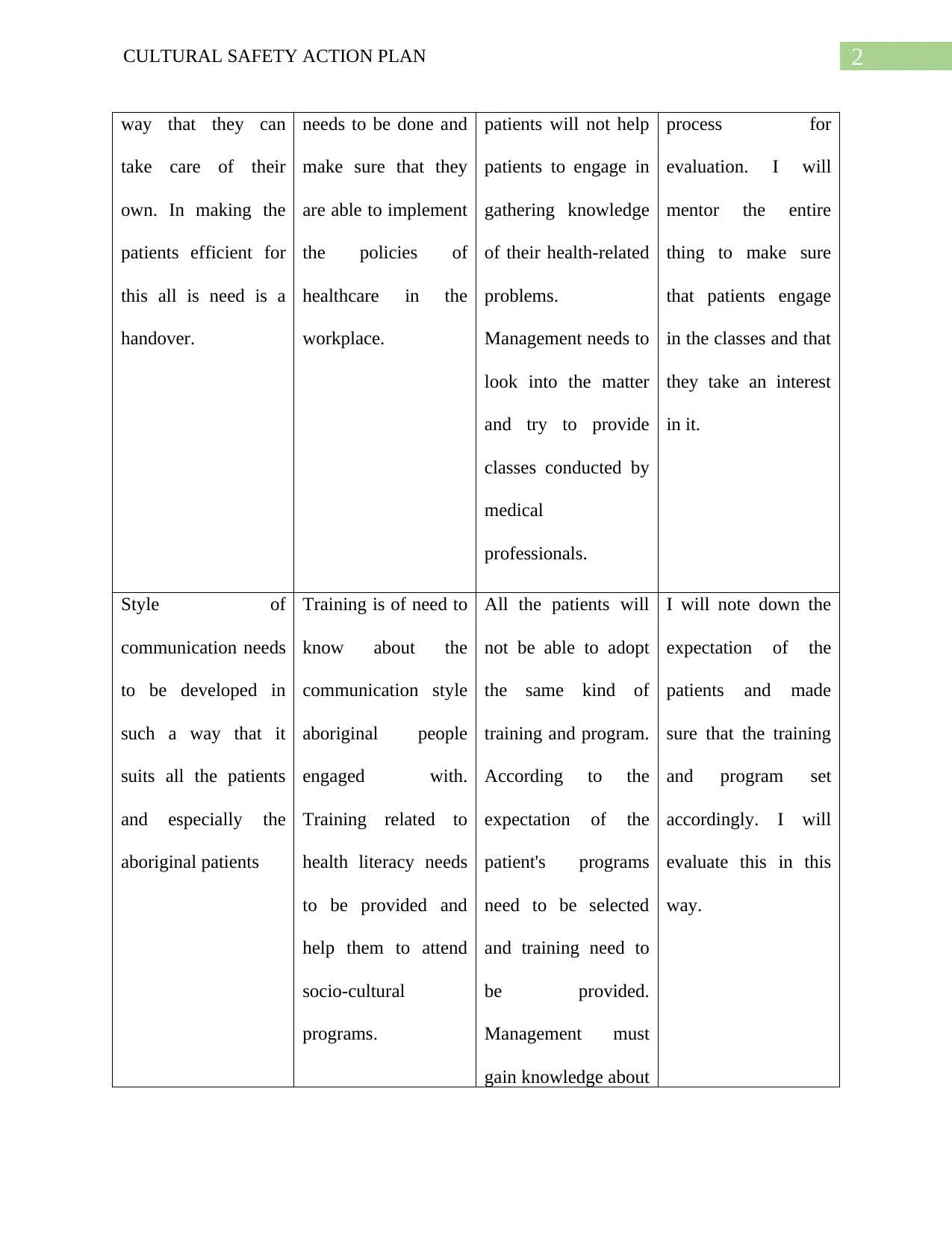
2CULTURAL SAFETY ACTION PLAN
way that they can
take care of their
own. In making the
patients efficient for
this all is need is a
handover.
needs to be done and
make sure that they
are able to implement
the policies of
healthcare in the
workplace.
patients will not help
patients to engage in
gathering knowledge
of their health-related
problems.
Management needs to
look into the matter
and try to provide
classes conducted by
medical
professionals.
process for
evaluation. I will
mentor the entire
thing to make sure
that patients engage
in the classes and that
they take an interest
in it.
Style of
communication needs
to be developed in
such a way that it
suits all the patients
and especially the
aboriginal patients
Training is of need to
know about the
communication style
aboriginal people
engaged with.
Training related to
health literacy needs
to be provided and
help them to attend
socio-cultural
programs.
All the patients will
not be able to adopt
the same kind of
training and program.
According to the
expectation of the
patient's programs
need to be selected
and training need to
be provided.
Management must
gain knowledge about
I will note down the
expectation of the
patients and made
sure that the training
and program set
accordingly. I will
evaluate this in this
way.
way that they can
take care of their
own. In making the
patients efficient for
this all is need is a
handover.
needs to be done and
make sure that they
are able to implement
the policies of
healthcare in the
workplace.
patients will not help
patients to engage in
gathering knowledge
of their health-related
problems.
Management needs to
look into the matter
and try to provide
classes conducted by
medical
professionals.
process for
evaluation. I will
mentor the entire
thing to make sure
that patients engage
in the classes and that
they take an interest
in it.
Style of
communication needs
to be developed in
such a way that it
suits all the patients
and especially the
aboriginal patients
Training is of need to
know about the
communication style
aboriginal people
engaged with.
Training related to
health literacy needs
to be provided and
help them to attend
socio-cultural
programs.
All the patients will
not be able to adopt
the same kind of
training and program.
According to the
expectation of the
patient's programs
need to be selected
and training need to
be provided.
Management must
gain knowledge about
I will note down the
expectation of the
patients and made
sure that the training
and program set
accordingly. I will
evaluate this in this
way.
⊘ This is a preview!⊘
Do you want full access?
Subscribe today to unlock all pages.

Trusted by 1+ million students worldwide
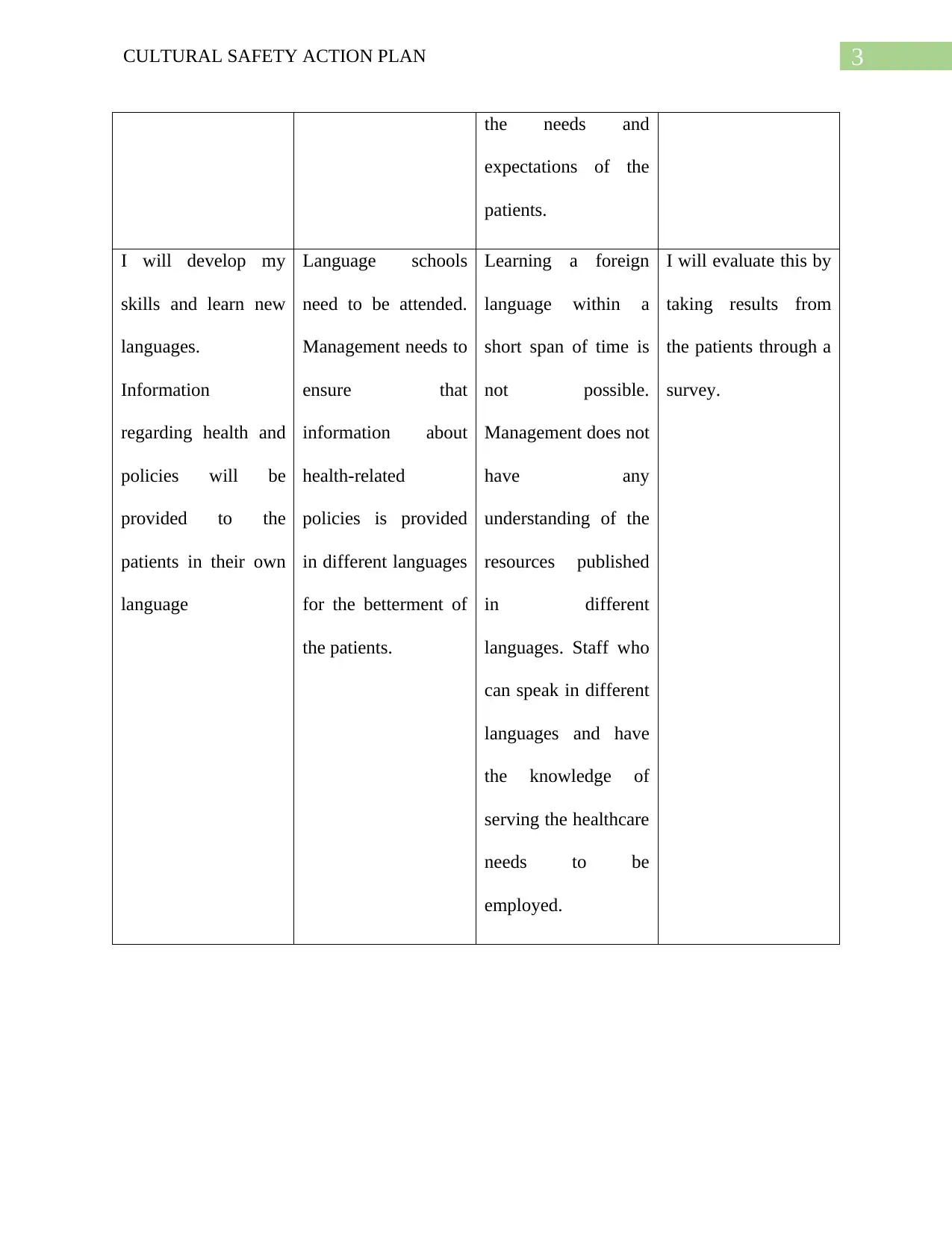
3CULTURAL SAFETY ACTION PLAN
the needs and
expectations of the
patients.
I will develop my
skills and learn new
languages.
Information
regarding health and
policies will be
provided to the
patients in their own
language
Language schools
need to be attended.
Management needs to
ensure that
information about
health-related
policies is provided
in different languages
for the betterment of
the patients.
Learning a foreign
language within a
short span of time is
not possible.
Management does not
have any
understanding of the
resources published
in different
languages. Staff who
can speak in different
languages and have
the knowledge of
serving the healthcare
needs to be
employed.
I will evaluate this by
taking results from
the patients through a
survey.
the needs and
expectations of the
patients.
I will develop my
skills and learn new
languages.
Information
regarding health and
policies will be
provided to the
patients in their own
language
Language schools
need to be attended.
Management needs to
ensure that
information about
health-related
policies is provided
in different languages
for the betterment of
the patients.
Learning a foreign
language within a
short span of time is
not possible.
Management does not
have any
understanding of the
resources published
in different
languages. Staff who
can speak in different
languages and have
the knowledge of
serving the healthcare
needs to be
employed.
I will evaluate this by
taking results from
the patients through a
survey.
Paraphrase This Document
Need a fresh take? Get an instant paraphrase of this document with our AI Paraphraser
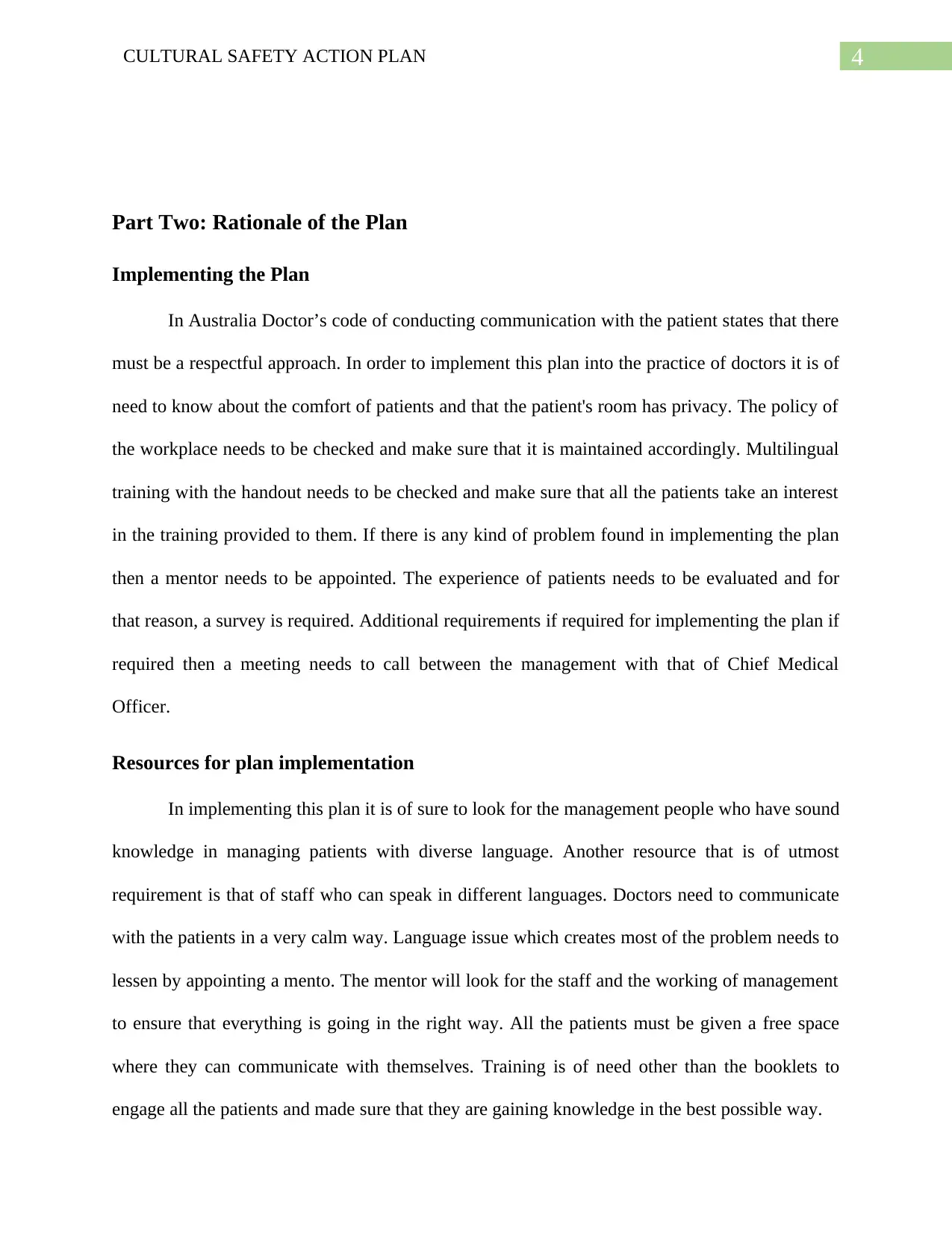
4CULTURAL SAFETY ACTION PLAN
Part Two: Rationale of the Plan
Implementing the Plan
In Australia Doctor’s code of conducting communication with the patient states that there
must be a respectful approach. In order to implement this plan into the practice of doctors it is of
need to know about the comfort of patients and that the patient's room has privacy. The policy of
the workplace needs to be checked and make sure that it is maintained accordingly. Multilingual
training with the handout needs to be checked and make sure that all the patients take an interest
in the training provided to them. If there is any kind of problem found in implementing the plan
then a mentor needs to be appointed. The experience of patients needs to be evaluated and for
that reason, a survey is required. Additional requirements if required for implementing the plan if
required then a meeting needs to call between the management with that of Chief Medical
Officer.
Resources for plan implementation
In implementing this plan it is of sure to look for the management people who have sound
knowledge in managing patients with diverse language. Another resource that is of utmost
requirement is that of staff who can speak in different languages. Doctors need to communicate
with the patients in a very calm way. Language issue which creates most of the problem needs to
lessen by appointing a mento. The mentor will look for the staff and the working of management
to ensure that everything is going in the right way. All the patients must be given a free space
where they can communicate with themselves. Training is of need other than the booklets to
engage all the patients and made sure that they are gaining knowledge in the best possible way.
Part Two: Rationale of the Plan
Implementing the Plan
In Australia Doctor’s code of conducting communication with the patient states that there
must be a respectful approach. In order to implement this plan into the practice of doctors it is of
need to know about the comfort of patients and that the patient's room has privacy. The policy of
the workplace needs to be checked and make sure that it is maintained accordingly. Multilingual
training with the handout needs to be checked and make sure that all the patients take an interest
in the training provided to them. If there is any kind of problem found in implementing the plan
then a mentor needs to be appointed. The experience of patients needs to be evaluated and for
that reason, a survey is required. Additional requirements if required for implementing the plan if
required then a meeting needs to call between the management with that of Chief Medical
Officer.
Resources for plan implementation
In implementing this plan it is of sure to look for the management people who have sound
knowledge in managing patients with diverse language. Another resource that is of utmost
requirement is that of staff who can speak in different languages. Doctors need to communicate
with the patients in a very calm way. Language issue which creates most of the problem needs to
lessen by appointing a mento. The mentor will look for the staff and the working of management
to ensure that everything is going in the right way. All the patients must be given a free space
where they can communicate with themselves. Training is of need other than the booklets to
engage all the patients and made sure that they are gaining knowledge in the best possible way.
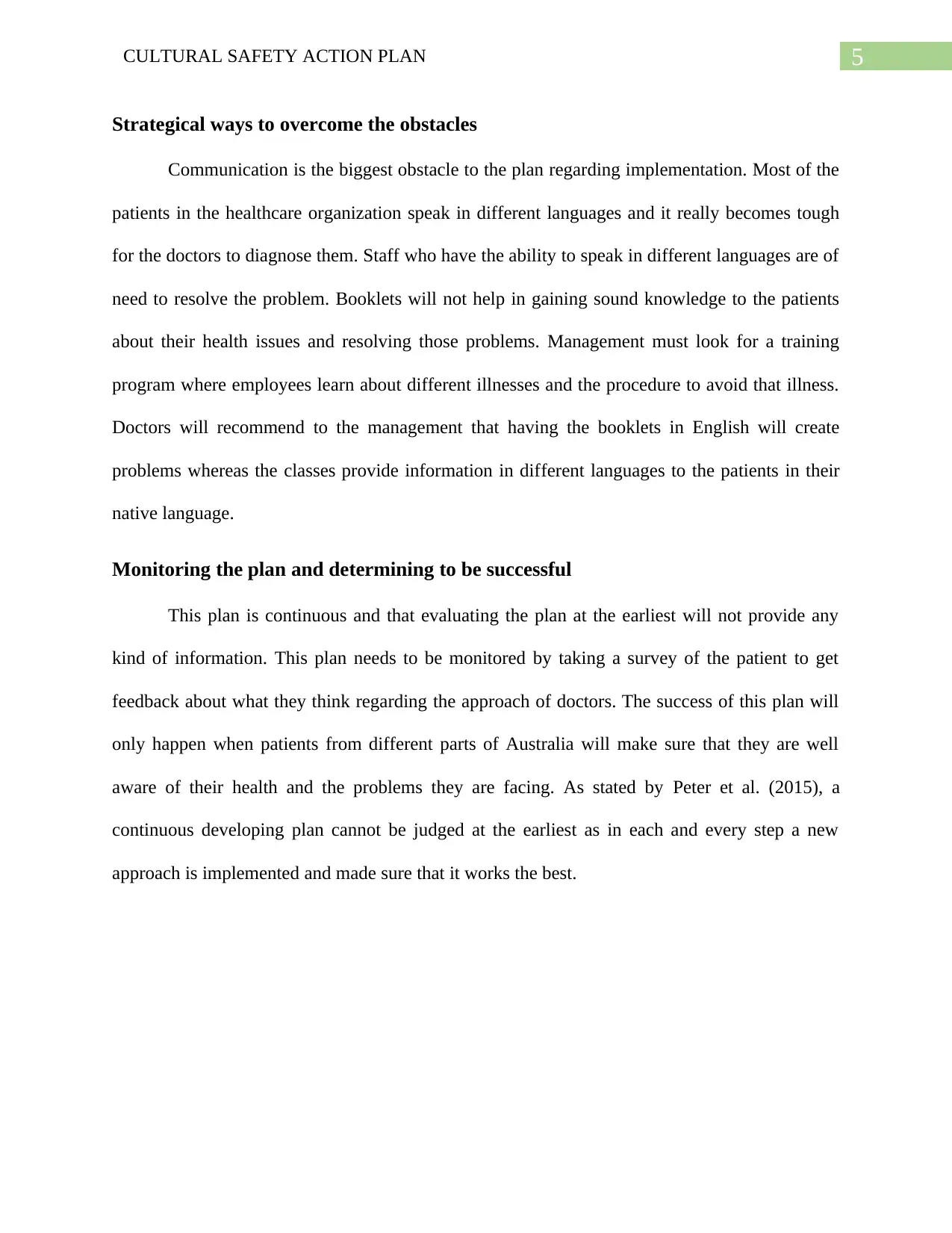
5CULTURAL SAFETY ACTION PLAN
Strategical ways to overcome the obstacles
Communication is the biggest obstacle to the plan regarding implementation. Most of the
patients in the healthcare organization speak in different languages and it really becomes tough
for the doctors to diagnose them. Staff who have the ability to speak in different languages are of
need to resolve the problem. Booklets will not help in gaining sound knowledge to the patients
about their health issues and resolving those problems. Management must look for a training
program where employees learn about different illnesses and the procedure to avoid that illness.
Doctors will recommend to the management that having the booklets in English will create
problems whereas the classes provide information in different languages to the patients in their
native language.
Monitoring the plan and determining to be successful
This plan is continuous and that evaluating the plan at the earliest will not provide any
kind of information. This plan needs to be monitored by taking a survey of the patient to get
feedback about what they think regarding the approach of doctors. The success of this plan will
only happen when patients from different parts of Australia will make sure that they are well
aware of their health and the problems they are facing. As stated by Peter et al. (2015), a
continuous developing plan cannot be judged at the earliest as in each and every step a new
approach is implemented and made sure that it works the best.
Strategical ways to overcome the obstacles
Communication is the biggest obstacle to the plan regarding implementation. Most of the
patients in the healthcare organization speak in different languages and it really becomes tough
for the doctors to diagnose them. Staff who have the ability to speak in different languages are of
need to resolve the problem. Booklets will not help in gaining sound knowledge to the patients
about their health issues and resolving those problems. Management must look for a training
program where employees learn about different illnesses and the procedure to avoid that illness.
Doctors will recommend to the management that having the booklets in English will create
problems whereas the classes provide information in different languages to the patients in their
native language.
Monitoring the plan and determining to be successful
This plan is continuous and that evaluating the plan at the earliest will not provide any
kind of information. This plan needs to be monitored by taking a survey of the patient to get
feedback about what they think regarding the approach of doctors. The success of this plan will
only happen when patients from different parts of Australia will make sure that they are well
aware of their health and the problems they are facing. As stated by Peter et al. (2015), a
continuous developing plan cannot be judged at the earliest as in each and every step a new
approach is implemented and made sure that it works the best.
⊘ This is a preview!⊘
Do you want full access?
Subscribe today to unlock all pages.

Trusted by 1+ million students worldwide
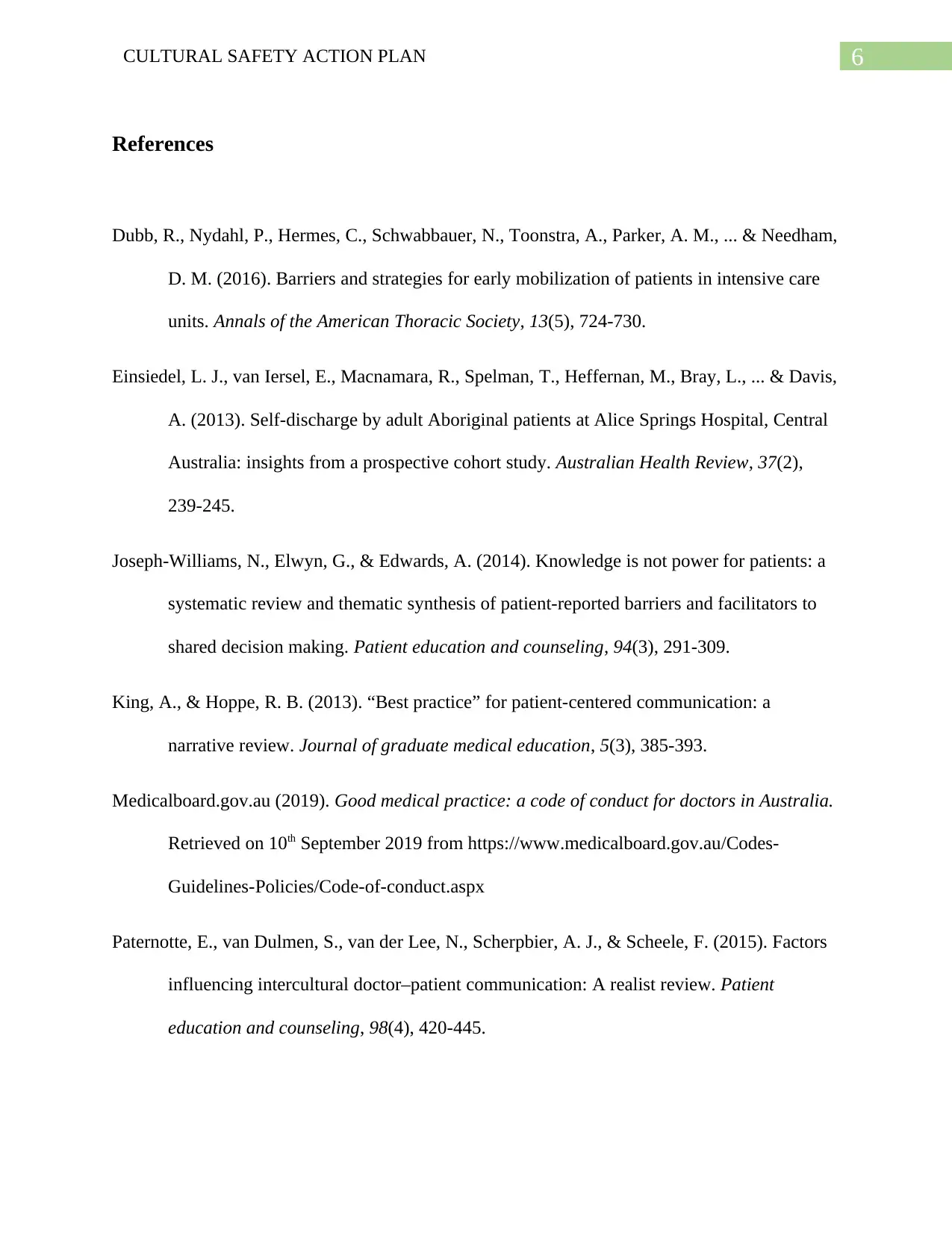
6CULTURAL SAFETY ACTION PLAN
References
Dubb, R., Nydahl, P., Hermes, C., Schwabbauer, N., Toonstra, A., Parker, A. M., ... & Needham,
D. M. (2016). Barriers and strategies for early mobilization of patients in intensive care
units. Annals of the American Thoracic Society, 13(5), 724-730.
Einsiedel, L. J., van Iersel, E., Macnamara, R., Spelman, T., Heffernan, M., Bray, L., ... & Davis,
A. (2013). Self-discharge by adult Aboriginal patients at Alice Springs Hospital, Central
Australia: insights from a prospective cohort study. Australian Health Review, 37(2),
239-245.
Joseph-Williams, N., Elwyn, G., & Edwards, A. (2014). Knowledge is not power for patients: a
systematic review and thematic synthesis of patient-reported barriers and facilitators to
shared decision making. Patient education and counseling, 94(3), 291-309.
King, A., & Hoppe, R. B. (2013). “Best practice” for patient-centered communication: a
narrative review. Journal of graduate medical education, 5(3), 385-393.
Medicalboard.gov.au (2019). Good medical practice: a code of conduct for doctors in Australia.
Retrieved on 10th September 2019 from https://www.medicalboard.gov.au/Codes-
Guidelines-Policies/Code-of-conduct.aspx
Paternotte, E., van Dulmen, S., van der Lee, N., Scherpbier, A. J., & Scheele, F. (2015). Factors
influencing intercultural doctor–patient communication: A realist review. Patient
education and counseling, 98(4), 420-445.
References
Dubb, R., Nydahl, P., Hermes, C., Schwabbauer, N., Toonstra, A., Parker, A. M., ... & Needham,
D. M. (2016). Barriers and strategies for early mobilization of patients in intensive care
units. Annals of the American Thoracic Society, 13(5), 724-730.
Einsiedel, L. J., van Iersel, E., Macnamara, R., Spelman, T., Heffernan, M., Bray, L., ... & Davis,
A. (2013). Self-discharge by adult Aboriginal patients at Alice Springs Hospital, Central
Australia: insights from a prospective cohort study. Australian Health Review, 37(2),
239-245.
Joseph-Williams, N., Elwyn, G., & Edwards, A. (2014). Knowledge is not power for patients: a
systematic review and thematic synthesis of patient-reported barriers and facilitators to
shared decision making. Patient education and counseling, 94(3), 291-309.
King, A., & Hoppe, R. B. (2013). “Best practice” for patient-centered communication: a
narrative review. Journal of graduate medical education, 5(3), 385-393.
Medicalboard.gov.au (2019). Good medical practice: a code of conduct for doctors in Australia.
Retrieved on 10th September 2019 from https://www.medicalboard.gov.au/Codes-
Guidelines-Policies/Code-of-conduct.aspx
Paternotte, E., van Dulmen, S., van der Lee, N., Scherpbier, A. J., & Scheele, F. (2015). Factors
influencing intercultural doctor–patient communication: A realist review. Patient
education and counseling, 98(4), 420-445.
Paraphrase This Document
Need a fresh take? Get an instant paraphrase of this document with our AI Paraphraser
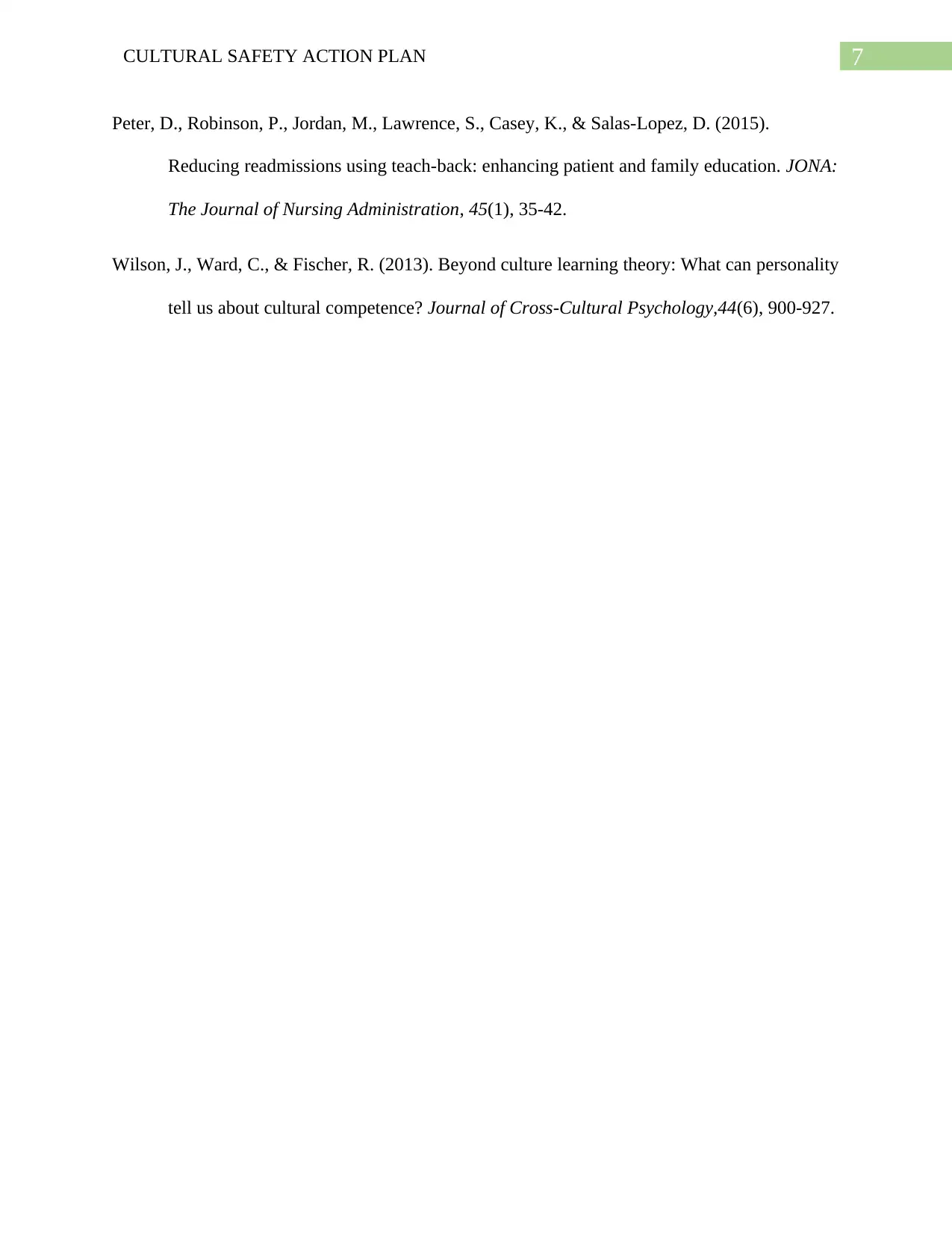
7CULTURAL SAFETY ACTION PLAN
Peter, D., Robinson, P., Jordan, M., Lawrence, S., Casey, K., & Salas-Lopez, D. (2015).
Reducing readmissions using teach-back: enhancing patient and family education. JONA:
The Journal of Nursing Administration, 45(1), 35-42.
Wilson, J., Ward, C., & Fischer, R. (2013). Beyond culture learning theory: What can personality
tell us about cultural competence? Journal of Cross-Cultural Psychology,44(6), 900-927.
Peter, D., Robinson, P., Jordan, M., Lawrence, S., Casey, K., & Salas-Lopez, D. (2015).
Reducing readmissions using teach-back: enhancing patient and family education. JONA:
The Journal of Nursing Administration, 45(1), 35-42.
Wilson, J., Ward, C., & Fischer, R. (2013). Beyond culture learning theory: What can personality
tell us about cultural competence? Journal of Cross-Cultural Psychology,44(6), 900-927.
1 out of 8
Related Documents
Your All-in-One AI-Powered Toolkit for Academic Success.
+13062052269
info@desklib.com
Available 24*7 on WhatsApp / Email
![[object Object]](/_next/static/media/star-bottom.7253800d.svg)
Unlock your academic potential
Copyright © 2020–2025 A2Z Services. All Rights Reserved. Developed and managed by ZUCOL.





